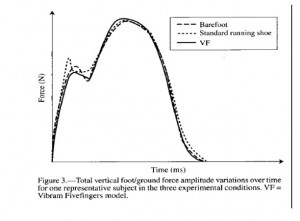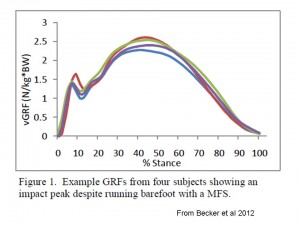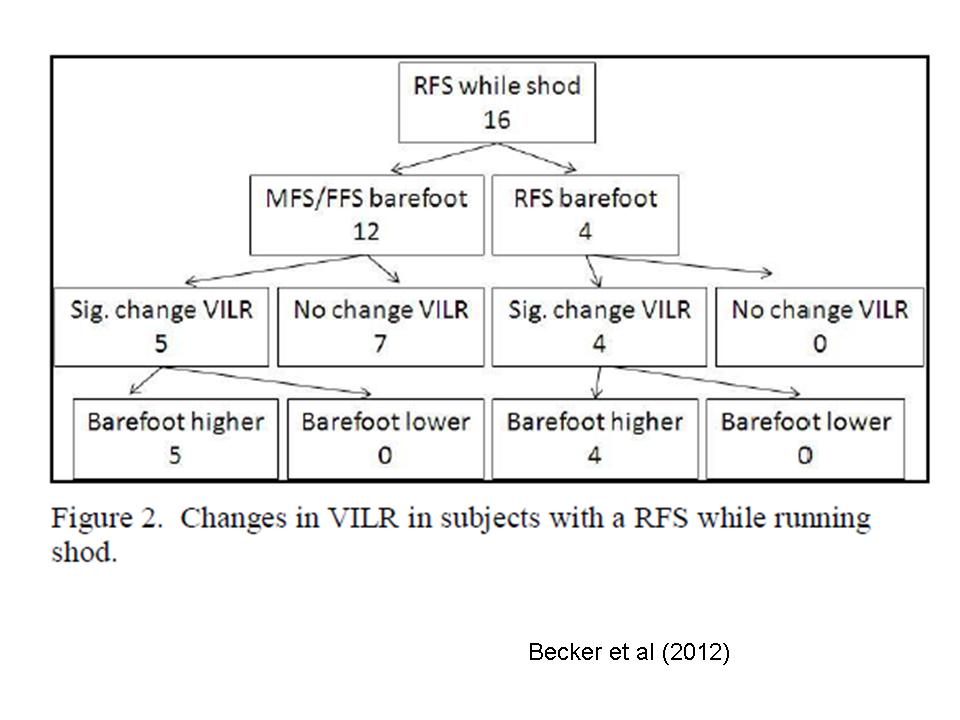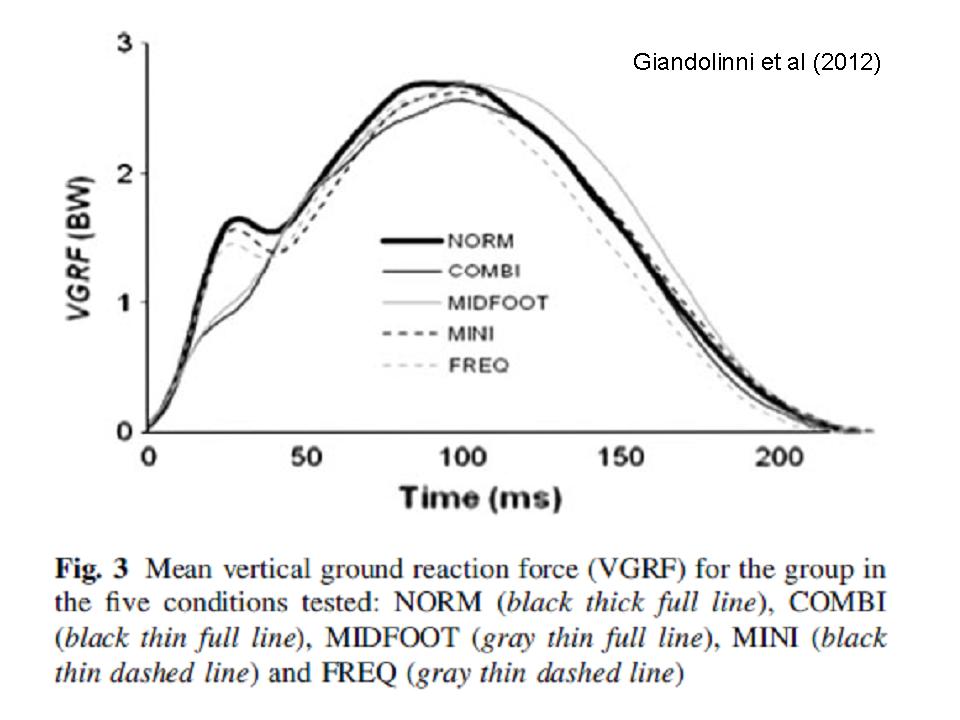Purpose: To review some of the data on ground reaction forces during running, the significance of this physical loading and how loading can be modified.
WARNING: this post is massive. It is meant as a working and evolving repository of much of the research on this topic. It is a compilation that I would like to update as more work is added. I use a post like this as a living reference library so I don’t have to search through an entire article to get the gist of it. It is not meant to win a writing award. Skip to the bottom for a summary.
What is in this post
1. Ground reaction forces (GRFs) overview
2. Relationship between GRFs and Injury
3. Modifying loading with step rate
4. Modifying loading with foot strike style
5. Modifying loading with shoe wear or going barefoot.
What are ground reaction forces and impact loading?
When the foot strikes the ground during running the ground produces a force back against the foot. The force can be broken into three directional vectors:
1. Vertical
2. Forward - Backwards (e.g. “braking” and then “push off”)
3. Side to Side.
Most of the research has focused on the Vertical loading so I will too. Vertical loading looks like this:
The first peak in force is termed the impact peak and results from the collision of the foot with the ground. We can also look at how quickly this force rises and when that peak occurs. This is called the rate of loading.
The second peak is called the active peak. It corresponds to the point when the energy absorption has stopped (the center of mass is at its lowest) and when we start to “push” off against the ground.
Relationship between ground reaction forces (GRFs) and injury
The relationship is contentious. It is simple to assume that less load or less stress on the body leads to a reduction in injury risk. But this does not always pan out. The human body has the ability to adapt and the variability across runners’ ability to adapt is huge. Simply, we don’t know how much load is bad for an individual person. You can even argue that loading is good in that this is what stimulates an adaptation in the runner (e.g. stronger bones, stronger soft tissue, a better nervous system?). What the cutoff is between good loading leading to adaptation and too much loading leading to injury is our Holy Grail of Injury Prevention. The concept of loading and loading rate on injury in runners could be a long post itself - I will just link to some articles below and briefly touch on this area.
There is some suggestion that the rate of impact loading is related to stress fractures in runners. See this post here and the abstract here. We also have some suggestion that decreasing peak loading can influence stress fracture risk (abstract here and here)
We also have some great research by Dr Irene Davis linking higher impact velocity (e.g rate of loading) with stress fractures (link here). Dr. Davis has also published case series showing changes in loading rates with feedback during running (abstract here).
Some links to follow for more information on this.
Davis and company (here, here, here, an outlier here)
Other researchers showing no relationship with loading and injury ( here and here)
So How Can We Modify Loading During Ground Contact?
In the following sections we will take a look at three methods that are used to change loading during foot strike:
- Changing step rate
- Changing type of foot strike (i.e. rearfoot versus midfoot)
- Changing footwear (or foregoing footwear altogether)
In an upcoming post I will review what other changes occur when we attempt to make these changes to impact loading. Changes don’t exist in a vacuum. They could lead to changes in running economy, muscular activation or other unintended consequences that could affect performance and maybe injury risk.
The Bottom Line before the bottom
All three techniques are able to change impact loading and joint loading in some individuals but not in all individuals. What we see in the research is variability and this leads to conflicting results across studies. This is because there are other factors than the three above that influence the ground reaction force. For example, you can change to a midfoot or forefoot strike and still overstride (see a neat video and case on this here). The stiffness in our limbs can all influence impact. This is what happens to some extent with kinematic changes with aging. Older runners can have similar stride rates but still have greater impacts (for a brief review see here). But lets look at some research.
A. Changing step rate
We can increase the number of steps we take while running. Heiderscheit et al (2011) did such a thing (for detailed review of the study look here and here). He increased step rate by 5 and 10%. This is some of what they found:
At both 5 and 10% increases in cadence
- decreased step length
- decreased Center of Mass vertical excursion (less bouncing up and down)
- decreased horizontal distance from the center of mass to the foot (i.e. less overstriding in front of you)
- less knee flexion (excursion) during the foot contact (i.e. increases stiffness)
- decreased energy absorption and energy production at the knee
- decrease in the impact transient occurrence (there were times when runners did not have that sharp spike in ground reaction force plot)
-
- decreased braking impulse
At a 10% increase in cadence only
- decrease in foot inclination angle at contact (toes point down more)
- decreased stance time duration
- increased rating of perceived exertion
- less hip flexion and adduction
- increased knee flexion at initial contact
- decreased peak vertical ground reaction force
- decreased energy absorption at the hip
A note on the ankle
There was no change in the amount of ankle energy absorption when increasing cadence yet a huge decrease in the amount of energy absorbed at the knee. This is most likely due to a lack of change in the ankle kinematics and how the foot struck the ground. I would guess that changing cadence was not enough to change the type of foot strike. If an individual went from a rearfoot to a mid or forefoot strike we would probably see more energy absorption at the ankle. Take home point, is that a lot variables can influence impact loading.
A note on the initial impact loading and loading rate
The authors found that reducing step length decreased the occurrences of that sharp initial bump in the ground reaction force. This is the impact transient and is what we most see in runners who heel strike - it is essentially the collision force with the ground. However, it was rarely seen (0-1 times in every 5 strides) only 56% of the time when increasing step rate by 10% (this lack of impact transient was seen 22% at preferred step length). So notice this is just a trend in some runners. If you notice with the study the authors did not calculate the average loading rate across all runners. This is how we typically compare loading rates across interventions. I would guess with the variability across the subjects we would not end up with a statistically significant change in loading rate. Presenting the data in this way shows us that sometimes we get a change in the impact transient just not always. As a refresher here is a lovely video of the loss of the impact transient with forefoot running.
Hobara (2012 -abstract here ) had athletes run at 2.5 meters per second and also modified step frequency (increasing huge amounts of 15 and 30%). They found decreases in:
- vertical impact peak (VIP),
- vertical instantaneous loading rate (VILR) and
- vertical average loading rate (VALR).
The only issue with this study is how practical it is to have such a huge change in stride rates. It is great for a proof of principle but we should question whether we want to do this in terms of running economy and even injury risk (i.e. you are taking a lot more strides thus increasing repetitions).
…and the other side of things (nothing is ever that simple)
But, these findings were mildly contrasted with another neat study that looked at changing a number of things (step rate, foot contact style and type of shoe) and the loading response. Giandolini (2012) found the following when increasing cadence 10%:
- no change in the rate of impact loading
- no change in the impact transient
- no change in the time that your foot is on the ground
- a decrease in the aerial time (time you are in flight)
- increase in stiffness (vertical)
These authors looked at the group average for changes in rate of impact loading. They don’t show their raw data so it is possible that there may have been some individuals who decreased their rate of impact loading and perhaps lost the impact transient during initial foot strike. This would be consistent with the Heiderscheit study.
In this comprehensive study, these authors were also able to change a number of loading and kinematic variables with other interventions. They did two other things - put runners in a racing shoe (versus a big bulky cushioned shoe) and had the runners switch from a rear foot strike to a mid foot strike. They also combined all three changes (COMBI). So why don’t we take a look at this neat-o study along with other relevant studies that look at changing footstrike style.
B. Switching to a Midfoot Strike
The research suggesting changing foot strike influences loading variables
This simple change provided some pretty drastic results. Giandollini et al (2012) found:
- loss of the impact transient when switching (also found in the COMBI)
- greater than 50% decrease in the rate of loading (also found in COMBI)
- interestingly no change in step rate (this is of interest because we often assume that this happens with a midfoot strike. We typically assume that running midfoot versus the heel naturally shortens the stride - suggesting that we can get changes in loading rates without decreasing stride length)
- an increase in Gastroc (calf muscle) and Tibialis Anterior (shin muscle) muscle activity was found just before impact but not during impact. However, the authors did not account for the electromechanical delay (i.e. the muscle turns on immediately but it takes time to take up the slack of the muscle to create force against the bones) that occurs with EMG muscle activity so we shouldn’t conclude that the muscles are not creating less force during impact. With the delay these muscles are creating force and are mostly likely contributing to the buffering of the impact loading response.
You can see a video version of this response in the video above from Dr. Lieberman.
…again it is never that simple. Similar research has found different conclusions
Laughton, Davis and Hamill (2003) investigated fifteen habitually rearfoot strike runners and then converted them to a forefoot strike pattern in a single session. The authors found:
- increased average peak vertical ground reaction force
- increased Anterior to Posterior GRF
- Increased Anterior to Posterior loading rates
- no difference in average or instantaneous GRF loading rates
some other findings:
- increased dorsiflexion and calcaneal eversion excursion
- decreased centre of mass excursion during foot contact
- increased knee flexion at initial contact
- decreased knee flexion excursion
- increased knee and leg stiffness
- decreased ankle stiffness
WHOA…this is very conflicting. Sure is. It again stresses that changing a single variable is not sufficient to change other variables. Changing to this type of forefoot strike pattern either increased peak loading, no change in loading rates, increased braking forces and increased knee and leg stiffness. We don’t know if stride rate changes but the increased anterior-posterior forces suggest that the forefoot striking may have been related to overstriding. Last, in this particular study the forefoot strikers were not permitted to let their heels hit the ground. They essentially ran on their toes. The Giandollini suggests that converting to midfoot strike can be beneficial (in terms of impact and force variables) but there may be a correct way to do this. i.e. don’t just run on your toes
Further research showing variable impact loading with changes in footstrike
Becker et al (2012) in an abstract presented at the ASB 2012 concluded that foot strike pattern does not predict loading rates during shod or barefoot running. With a subject population of 11 (this study was reported as ongoing so it looks like it may be more robust in the future). The authors measured vertical impact loading rate and strike pattern in the runners when they ran either shod or barefoot. What they were able to evaluate was how footstrike pattern related to VILR in quite a novel way. The participants were not told to attempt to change their foot strike pattern. Rather, they had people either run with their shoes or in barefoot and measured their footstrike pattern with something called a Strike Index while also measuring their VILR. With these two measures in hand they determined how foot strike pattern related to VILR because some people would naturally change from a rearfoot pattern while shod to a forefoot pattern while barefoot. So, there were few permutations on what could happen. Here is a sample of what I see as relevant and check out the chart below for all the details.
Lets look at those instances where people RFS while shod but ended up switching to a forefoot strike while barefoot:
- 12/16 switched from a RFS to MFS/FFS while 4/16 remained RFS while barefoot
- of the 12 that switched 5 of them significant increased their VILR while 7 had no change.
- of the 5 that showed changes when going to a MFS/FFS while barefoot all of them showed increases in loading rates while non showed decreases.
- Figure 1 below shows no loss in the impact transient in subjects running with a midfoot strike
The flow chart below shows what happens to the vertical loading rate to individual runners when they either change to a midfoot/forefoot strike (MFS/FFS) while barefoot or remain heel striking (RFS)
The bottom line from this study is that a mere shift to a MFS/FFS is not sufficient to get less VILR. This study is also confounded with the shift from the shod to barefoot but it again suggests that is not a sufficient condition to automatically assume you will get less loading rates. Big limitation: there was no training or time allowed for habituation. This is short term study and may not reflect what happens with motor learning over time.
C. Impact and loading changes when we change our shoes
I will cut right to the chase here. Changing your shoes is not always enough to get changes in loading variables. Big bulky shoes are knocked under the assumption that the ass of the shoe gets in the way and forces runners to land on their heels and overstride. We assume that replacing these shoes with lighter shoes (and less of a heel to toe drop) will lead to a change in how we run to avoid heel striking (due to pain) and overstriding. Lets look at the research on what happens in different shoes.
Possible Study Outcome #1: Traditional versus minimal shoes lead to variable changes in loading
Goss et al (2012) Accuracy of self-reported footstrike patterns and loading rates associated with traditional and minimalist running shoes (ASB 2012).
These authors looked at 57 runners who ran in either traditional running shoes (n=22) or minimalist running shoes (n=35). There were no details on what these minimal shoes were. The authors measured ground reaction force and were classified into either a rearfoot or forefoot runner. This gave three categories of people: 1. rearfoot striker with traditional shoes (TSR) 2. Midfoot striker in minimal shoes (MSA) and 3. rearfoot striker in minimalist shoes (MSR). Before doing the assessment they also asked the runners how they thought they struck the ground. Here is what they found:
- 1/3 of experienced minimal shoe wearing runners misclassified their running footstrike - they thought they were midfoot but they were hitting their heel.
- the MSA group (midfoot minimal) had the lowest average vertical loading rates (52.8 BW/s), traditional shoe rearfoot strikers were next (68.6 BW/s) and the rearfoot strikers with minimal shoes had the highest loading rates (107.8 BW/s).
- there was no change in peak ground reaction force across groups
- vertical ground reaction force curves were different between groups. Noticeable there is less of the impact transient in minimal shoes regardless of footstrike but midfoot striking with minimal shoes leads to the gentlest of loading rates. See chart below.
Possible Study Outcome #2: Shoes versus barefoot lead to increases in joint loading
Kerrigan et al (2009) looked at the influence of running shoes on lower extremity joint torques in standard running shoes and barefoot (n=68). They found increases in the following joint torques when going from barefoot to shod:
- hip adduction
- hip external rotation
- knee flexion, knee varus, knee internal rotation
- ankle internal rotation
In terms of ground reaction forces there were increases with shod running in:
- medial to lateral GRF and Vertical GRF
with a decrease in the minimum anterior to posterior GRF
Stride length was found to increase from 2.15 meters (barefoot) to 2.29 meters (shod) although the authors suggested that this accounted for only a small percentage of the changes in joint torques.
Possible Study Outcome #3: Minimal shoes lead to increases in joint loading
Logan et al (2012 - ASB Abstracts here) GROUND REACTION FORCES BETWEEN RUNNING SHOES, RACING FLATS AND DISTANCE SPIKES IN RUNNERS
The authors compared the three different shoes and aspects of the ground reaction force (Impact peak (BW), loading rate (BW/s), peak braking and propulsive force (BW), peak vertical force (BW), stance time (s), and vertical stiffness (BW/m)) in runners (n=18) who were all habitual rearfoot strikers. Further, these runners were college track athletes running between 5.67 -6.7 meters/s. This is fast considering that running around a 5 meter/second pace will have you run 5 km in 16:40. They found:
Impact peak and vertical stiffness significantly increased between running shoes and spikes. Differences between stance time and loading rate approached significance with trainers being lower
This again is interesting. I don’t know if these runners changed their foot strike with any of the shoes but it reiterates that changing shoes to a more minimal shoe is enough to positively lower loading variables. In this case it increased them. I would assume that these runners were still heel strikers despite the change in shoe. This group shows that you can have less of an impact peak, less vertical stiffness and a trend to having less loading rate with a trainer than with more minimal shoes. Take home point here is that our movement patterns involve motor learning…motor learning involves effort, time and conscious attempt to change how we move.
Possible Outcome #4: Shoe differences are minimal but going barefoot decreases loading variables.
…and now a contrary view Hamill et al (2011 with a detailed review here) in a study titled “Impact characteristics in shod and barefoot running”. The authors compared barefoot running with running shod in three different shoes of different sole thickness (1. A shoe with a 4mm heel and 0 mm forefoot; 2. a shoe with 12mm heel and 8mm forefoot and 3. a shoe with a 20mm heel and 16mm forefoot). The authors looked at the immediate response with these different shoes. Again, there was no training or attempts repatterning a gait stride. Their results in a nutshell were:
- switching to barefoot leads to an anterior footstrike pattern
- barefoot leads to less 50% of the loading rate of all footwear conditions
- impact peaks are still common with minimal shoes (a 4mm drop and very little thickness)
- there is a trend to decrease loading rate with decreasing shoe midsole thickness
- in general, shoes of different midsole thickness did not have different loading variables as runners in all shoes did not change their footstrike pattern
Possible Outcome #5: Minimal shoes show no effect on impact loading
The Giandollini (2012) study compared standard cushion shoes with a racing shoe (important note: the racing had a large heel to toe drop of 10.8 mm - thus some may not call this a minimal shoe despite there being less mass). The authors trained the participants and had them run at the same speed with the two different shoes on. The authors found no difference in loading rate, time to peak vertical load and peak vertical loading. The authors suggest that individuals continue to use a heelstrike style of running and that the minimal shoe did not coerce the runner into changing their running style. What I find interesting is that even though the racing shoe is much lighter with less cushioning there are no adverse consequences to running with a similar style compared with the normal cushioned shoe. Below is a nice graphic representation of all of Giandolinni’s interventions on the vertical ground reaction force.
Brief Summary of changing gait variables to influence impact loading
All methods can influence of impact and joint loading but not consistently.
Increasing step rate can decrease joint loading but does not always lead to a reduction in the impact transient or rate of impact loading
Changing to a midfoot strike does have evidence to change impact loading variables but again in some individuals we won’t see any change
Changing to a midfoot strike may also result in other factors that increase the strain on the tibia (link here for a start to this interesting idea). We can’t say with certainty that everyone should be doing this change. A follow up post must and will address this area.
Changing your shoes to lighter weight or minimal shoes also has variable effects. Most importantly, instances can exist where your loading can increase when going to lightweight, minimal shoes. Most likely due to maintaining the running style that you have adopted when running in your previous cushioned trainers
The Giandollini et al (2012) study is really quite lovely. They look at as many variables and interventions that you can reasonable look at. They show how many techniques of what we think might change impact don’t consistently change impact and they also provide insight into the “whys” of this. I also like their conclusion (probably because it agrees with something I wrote last year on barefoot running and foot strike style and I need reinforcement ![]() ) where they write:
) where they write:
our results show that running “barefoot-like”, i.e. with a midfoot strike pattern may be an effective solution to reduce the magnitude of impact, as quantified through the loading rate
Related Posts
Running economy, barefoot, minimal and traditional shoes
Barefoot and foot strike style running biomechanics review






